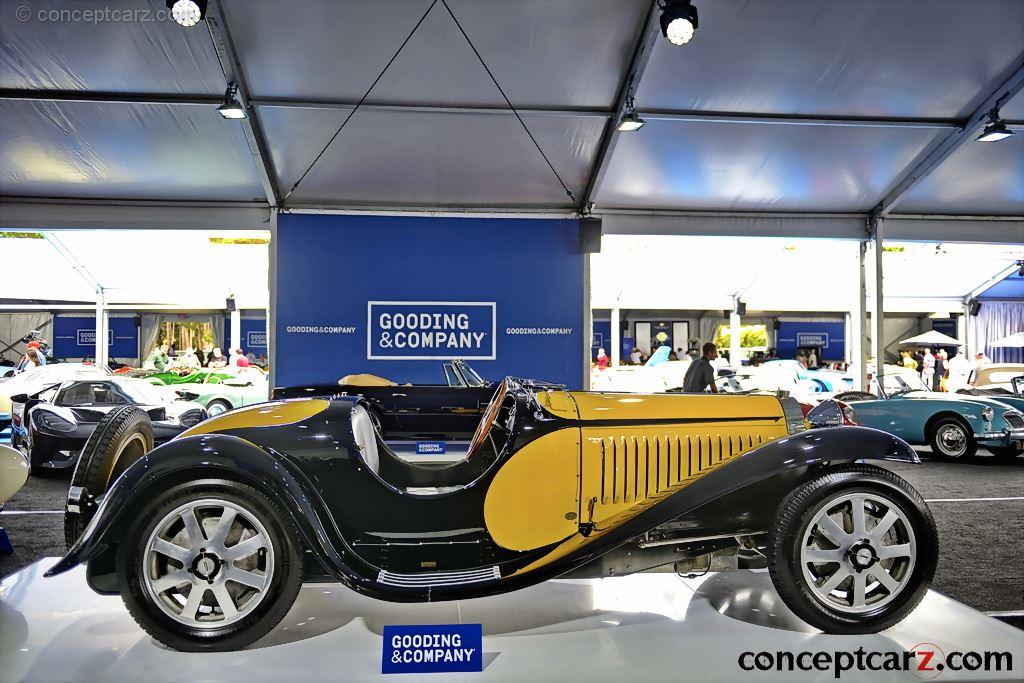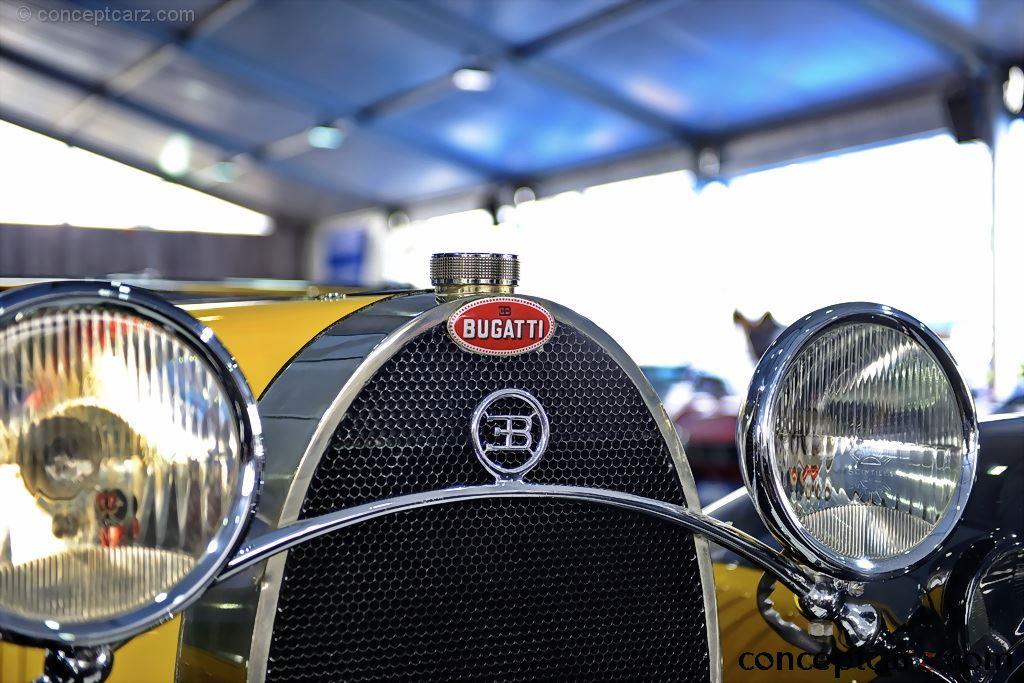Ettore Bugatti was born in Milan in 1881 to a family of distinguished artists and craftsmen, a lineage that no doubt contributed to his ability to revolutionize the world of high-performance automobiles. Early on, he recognized that performance was not solely dependent on increased engine size; instead, it could be obtained by reducing weight. Better acceleration, road-holding, and braking could be achieved via a lightweight sports car, along with reduced fuel consumption. Infused with an artist's sensibility, the cars of Ettore Bugatti were efficient, attractive, and well-engineered.
Roadster
Chassis #: 55231
Engine #: 32
View info and history
Auction entries : 1Like many early 20th-century automakers, Bugatti used its success in competition to elevate the profile of its road cars. Weighing a mere 1,500 lbs, Bugatti's Type 35 Grand Prix made its debut in 1924 at the Grand Prix of Lyon. With its overhead-camshaft straight-eight engine, it would become an integral component in Bugatti achieving over 2,000 race victories by 1927. The Bugatti Type 43 was the Grand Prix car for the road, with mechanical underpinnings of the Type 35B, along with the axles, radiator, and transmission from the TYpe 38. It has been called the first real 100 mph sports car, and its performance heritage made it suitable for sporting expeditions such as the Alpine Trial, circuit racing, and hill climbs.The first Grand Prix Bugatti to feature a dual overhead camshaft motor was the Type 51, available in three sizes: 2.3-liter, 2.0-liter, and 1.5-liter, all supercharged. The Type 51 won several major races during its first season, and it was a Type 51 that earned Bugatti's last significant Grand Prix victory against major opposition at the 1933 Monaco Grand Prix.
Roadster
Chassis #: 55231
Engine #: 32
View info and history
Auction entries : 1From these competition underpinnings, Bugatti birthed the Type 55 road car which soon became one of the most coveted sports cars of the early 1930s. It received the 2.3-liter engine of the Type 51 and retained its supercharger but was detuned to 130 horsepower to ensure tractability. Its fender lines and proportions combined harmoniously with its engineering technology, delivering a balance of looks and performance in an elegant package. Its chassis was from the deep-sided frame used in the Type 54 Grand Prix car, retaining the reverse quarter elliptic rear springing and front axle arrangement that hailed from the successful GP cars. A new format of gearbox similar to that used in the Type 49 transferred the power from the engine to the road.The iconic coachwork was influenced by Ettore Bugatti's son, Jean, with cut-down doors, sculpted moldings, a nickel silver radiator, alloy wheels, and a light bustle back tail. A mere thirty-eight examples of these Super Sport Bugattis left the Molsheim works between 1932 and 1935, with approximately 14 receiving the definitive Jean Bugatti Roadster coachwork and seven with coupe bodies. Factory bodies included a coupe, cabriolet, or roadster. Available as a rolling chassis, a number of coachbuilders such as Vanvooren, Figoni, and Gangloff created coachwork of their own design.
Roadster
Chassis #: 55231
Engine #: 32
View info and history
Auction entries : 1The Type 55 was the spiritual successor to the Type 43 Grand Sport, and it used the same chassis as the 16-cylinder Type 45 and Type 47 Grand Prix cars, also used in the 4.9-liter Type 54. Introduced in October 1931 at the Paris Motor Show, the Type 55 had a top speed in excess of 110 mph.Mechanical Specifications
The Bugattyp Type 55 rested on a 108.3 inch wheelbase chassis and its 2,262cc 2-valve DOHC straight-8 engine with a Roots-Type supercharger developed 130 horsepower at 5,000 RPM. It had a larger 9mm compression compared (compared to the 6 mm plate used by the Type 51), a modified supercharger drive, and a camshaft-driven AC mechanical petrol pump. The four-speed manual tranmsission had straight cut gears, braking was by four-wheel mechanical drums, and there was the signature Bugatti eight-spoke aluminum wheels. The solid front axle was suspended by semi-elliptical leaf springs, while the live rear axle used reversed quarter-elliptical leaf springs.Production
The Bugatti Type 55 was produced from 1932 to 1935, with 38 examples built. At least eleven examples were clothed by outside coachbuilders.
by Daniel Vaughan | Dec 2023

Roadster
Chassis #: 55231
Engine #: 32
View info and history
Auction entries : 1

Roadster
Chassis #: 55231
Engine #: 32
View info and history
Auction entries : 1

Roadster
Chassis #: 55231
Engine #: 32
View info and history
Auction entries : 1
The Bugattyp Type 55 rested on a 108.3 inch wheelbase chassis and its 2,262cc 2-valve DOHC straight-8 engine with a Roots-Type supercharger developed 130 horsepower at 5,000 RPM. It had a larger 9mm compression compared (compared to the 6 mm plate used by the Type 51), a modified supercharger drive, and a camshaft-driven AC mechanical petrol pump. The four-speed manual tranmsission had straight cut gears, braking was by four-wheel mechanical drums, and there was the signature Bugatti eight-spoke aluminum wheels. The solid front axle was suspended by semi-elliptical leaf springs, while the live rear axle used reversed quarter-elliptical leaf springs.Production
The Bugatti Type 55 was produced from 1932 to 1935, with 38 examples built. At least eleven examples were clothed by outside coachbuilders.
by Daniel Vaughan | Dec 2023
Related Reading : Bugatti Type 55 History
Bugatti had a distinguished history when it came time to produce the Type 55. Their resume included extremely successful race cars and elegant and sophisticated road-going vehicles. In the racing department, the minimalist Type 35 was a very competitive car that racked up many impressive victories. It was, like so many other Bugattis, available with either a naturally aspirated engine or with the....
Continue Reading >>
Continue Reading >>
Related Reading : Bugatti Type 55 History
Despite what every adolescent boy in America may tell you, the awe-inspiring Veyron was not Bugattis first car. Nor was it Bugattis first tribute to speed, excess, and unbridled wealth. The 16-cylinder, quad-turbo Veyron was conceived under Bugattis current Volkswagen ownership. Before the German takeover, the Italians had some fun with Bugatti as well. For a few years during the early 1990s,....
Continue Reading >>
Continue Reading >>
1933 Bugatti Type 55 Vehicle Profiles
Recent Vehicle Additions
Performance and Specification Comparison
Type 55 Specification Comparison by Year
Year
Production
Wheelbase
Engine
Prices
8 cyl., 138.04 CID.
Related Automotive News

Black and yellow: a timeless combination
Although Bugattis motorsport heritage is most associated with French Racing Blue, many of its most elegant cars were finished in the favorite color combination of its founder Ettore Bugatti black and yellow.
For true connoisseurs of the Bugatti...

Bugatti's Super Sport Legends
Four Bugatti models beyond compare and three singular Bugatti protagonists, each with unforgettable moments in their Super Sport.
Extremely fast and yet very comfortable – with the Chiron Super Sport 3001, Bugatti is once again redefining...

15 Years Of Bugatti Veyron – How It All Began
The production of the Veyron 16.4 started in 2005. We take a look at what happened years before.
Molsheim, 15 04 2020 In 1997, on the Shinkansen express train between Tokyo and Nagoya, a sketch was created that would change the automotive...

Bugatti Legends Type 41 LA Royale – A Royal Vehicle
In the 1920s, Bugatti created the most luxurious car in the world
Molsheim, 09 04 2020 With the Type 41 Royale, in 1926, Bugatti presented the strongest, largest and most luxurious automobile in the world, characterized by unimaginable...

MONDIAL DE L‘AUTOMOBILE PARIS: BUGATTI PRESENTS FINAL LEGENDS MODEL „ETTORE BUGATTI' AT VOLKSWAGEN GROUP NIGHT
European premiere for sixth and final model of the exclusive edition „Les Légendes de Bugatti
Entire Legends Edition sold out
Veyron on finishing straight Fewer than 20 vehicles available
Bugatti President Wolfgang Dürheimer The next Bugatti w...













